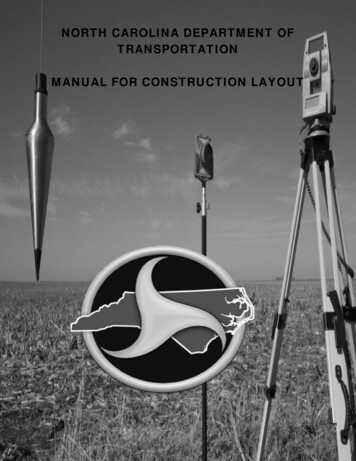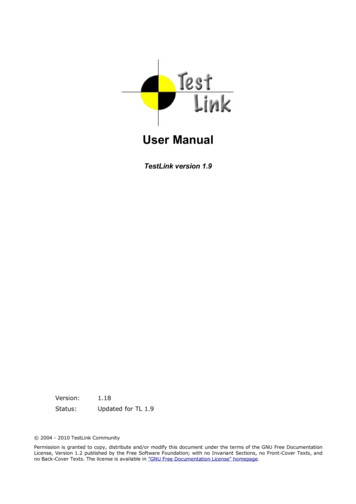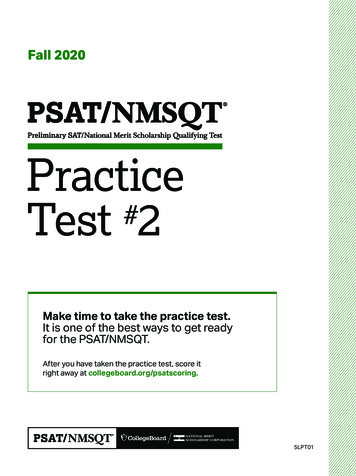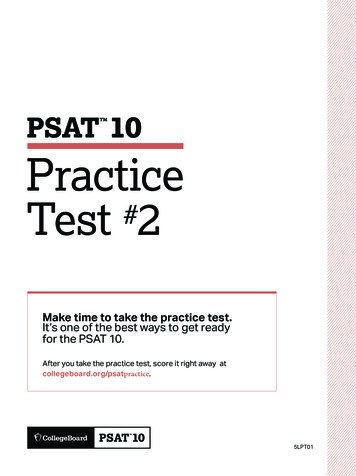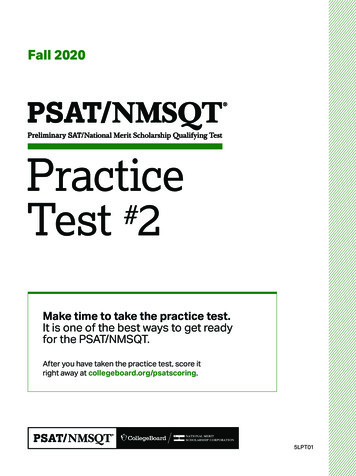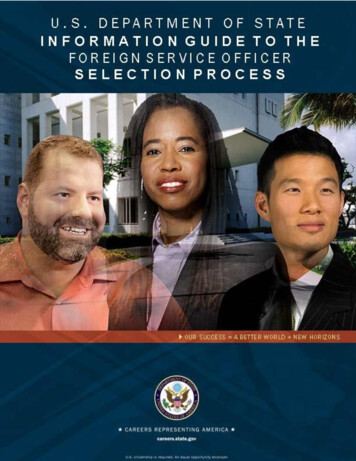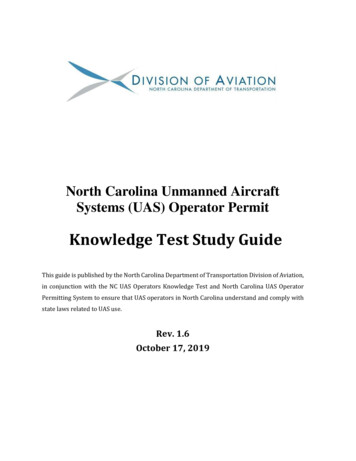
Transcription
North Carolina Unmanned AircraftSystems (UAS) Operator PermitKnowledge Test Study GuideThis guide is published by the North Carolina Department of Transportation Division of Aviation,in conjunction with the NC UAS Operators Knowledge Test and North Carolina UAS OperatorPermitting System to ensure that UAS operators in North Carolina understand and comply withstate laws related to UAS use.Rev. 1.6October 17, 2019
FOREWORDThe conversation around UAS operation continues to develop in the United States. Many stateshave yet to pass legislation regarding unmanned aircraft, and laws that are passed must evolveas the field grows and changes. Some aspects of unmanned flight are controversial and willremain so. However, the N.C. Department of Transportation is working to provide unbiasedguidance and support, as residents navigate the dynamic and exciting area of technology. Thisframework will help UAS users operate their equipment in a manner that complies with federaland state laws, setting a standard for responsible use for the rest of the country. Unmannedaircraft operators are responsible for the safety of those around them, both on the ground and inthe air. By following the laws and regulations set by the Federal Aviation Administration and theNorth Carolina General Assembly, (found in this handbook) users will help keep our airspace safewhile enjoying a productive and fun UAS experience.Completing the North Carolina UAS Operator Permit Knowledge Test gives users the opportunityto become pioneers in commercial and/or government operations of unmanned aircraft systems(UAS). Operators will have the ability to use technology recently thought impossible and help setthe standard for safety and excellence in an emerging field. The NCDOT Division of Aviation's goalis to make sure that UAS operations in North Carolina are safe and responsible.i
NC UAS OPERATOR PERMIT REQUIREMENTSNorth Carolina requires UAS/drone operators to have an UAS Operator Permit if they are flyingfor commercial purposes or are a government (public use) organization. Per North CarolinaGeneral Statute § 63-95 and § 63-96, the Division of Aviation administers the knowledge test andpermit. There is no cost to take the test or obtain an UAS Operator Permit. The permit is valid fortwo years from the date of issuance.Before you apply for your permit, please check the lists below. Commercial and Governmentoperators must have documents from the Federal Aviation Administration (FAA) before gettinga permit.After getting your documents, Commercial and Government operators must pass the NCDOT UASKnowledge Test. Immediately after passing the test on our website, you will be able to apply foryour permit online.CommercialGovernmentYou must have a valid AirmanCertificate.You must have a valid AirmanCertificate.You must be at least 16 yearsold.You must pass the NCDOTUAS Knowledge Test & applyfor your permit online atNCDOT: Division of Aviationwebsite.Commercial operators dohave to register their UASthrough the FAA's sUASwebsite.You must be at least 16 yearsold.You must pass the NCDOTUAS Knowledge Test & applyfor your permit online atNCDOT: Division of Aviationwebsite.Government operators dohave to register their UASthrough the FAA's sUASwebsite.RecreationalRecreational UAS/droneoperators do not need anOperator Permit.No minimum ageYou do not need to takeNCDOT UAS KnowledgeTest but it’s best practice toknow the NC state laws forUAS.Recreational operatorsmust register their UASthrough the FAA's sUASwebsite.ATTENTIONFor a step by step guide to taking your NC UAS knowledge test and how toapply for your permit please see Section 11 of this document.ii
Table of ContentsTable of ContentsFOREWORD 1NC UAS OPERATOR PERMIT REQUIREMENTS 2ATTENTION 2REGULATORY AUTHORITY: WHO GOVERNS WHAT? 3THE FEDERAL AVIATION ADMINISTRATIONTHE STATE OF NORTH CAROLINATHE NORTH CAROLINA DEPARTMENT OF TRANSPORTATION DIVISION OF AVIATIONOTHERS – LOCAL GOVERNMENTS AND NATIONAL PARKSINDOOR FLIGHT34455WHO SHOULD TAKE THE NORTH CAROLINA UAS KNOWLEDGE TEST? 6AUTHORIZATION TO FLY: WHAT DO I NEED? 10AIRCRAFT REGISTRATION 11PERMISSION TO FLY: AIRSPACE USE AUTHORIZATION 12PART 107 UAS OPERATIONS 12PUBLIC CERTIFICATES OF WAIVER OR AUTHORIZATION – FOR GOVERNMENT ENTITIES ONLY 14SECTION 333 EXEMPTIONS – FOR COMMERCIAL UAS OPERATORS 15AUTHORIZATION TO FLY: NORTH CAROLINA AUTHORIZATIONS 17NORTH CAROLINA STATUTES: WHAT CAN I DO? 18REGULATION OF LAUNCH AND RECOVERY SITES (§15A-300.2) 18GENERAL PROHIBITIONS AND CONSENT (§ 15A.300.1) 19USE OF AN UNMANNED AIRCRAFT SYSTEM NEAR A CONFINEMENT OR CORRECTIONAL FACILITYPROHIBITED ((§ 15A-300.3) 20LAW ENFORCEMENT EXCEPTIONS (§ 15A-300.1 (C)) 21EMERGENCY MANAGEMENT EXCEPTION (§ 15A-300.1 (C1)) 22UNWARRANTED SURVEILLANCE (§ 15A-300.1 & §14-401.25) 22UNLAWFUL DISTRIBUTION OF IMAGES (§ 14A-401.25) 23INTERFERENCE WITH MANNED AIRCRAFT BY UNMANNED AIRCRAFT SYSTEMS (§14-280.3) 23UNLAWFUL POSSESSION AND USE OF UNMANNED AIRCRAFT SYSTEMS (§14- 401.24) 24UNLAWFUL HARASSMENT OF PERSONS TAKING WILDLIFE RESOURCES (§113- 295) 25CRIMES COMMITTED BY USE OF UNMANNED AIRCRAFT SYSTEMS (§14-7.45) 26WHERE TO FIND CURRENT INFORMATION 27KEY OFFICE CONTACTS 27THE NORTH CAROLINA AIRPORT FACILITY DIRECTORY 27FAA CONTACT INFORMATION 27CURRENT UAS-RELATED INFORMATION 27NORTH CAROLINA UAS PERMIT – PERMITTING PROCEDURES 30WEBSITE 30AFTER THE TEST 31Commercial Permit 32Government Permit 33DOWNLOAD & PRINT UAS PERMIT 34iii
REQUIRED DOCUMENTATION FOR NC UAS COMMERCIAL OPERATIONS 35iv
List of FiguresFIGURE 1 - GOVERNMENT (PUBLIC) CERTIFICATE OF AUTHORIZATION ------------------------------------------- 15FIGURE 2 - LAUNCH AND RECOVERY ---------------------------------------- 18FIGURE 3 – PROPERTY ------------------------------------------------- 19FIGURE 4 - LAW ENFORCEMENT --------------------------------------------- 21FIGURE 5 - PRIVACY ----------- 22FIGURE 6 - SPECIAL IMAGING TECHNOLOGY ----------------------------- 23FIGURE 7 - INTERFERENCE WITH MANNED OPERATIONS ------------ 23FIGURE 8 - UNLAWFUL USE OF UAS ----------------------------------------- 24FIGURE 9 - INTERFERE WITH WILDLIFE RESOURCES ------------------ 25FIGURE 10 – CRIMES USINGUAS ----------------------------------------------- 26v
Important Acronyms and AbbreviationsAGLAbove Ground LevelATCAir Traffic ControlCOACertificate of Waiver or AuthorizationFAAFederal Aviation AdministrationFARFederal Aviation RegulationsKnowledge TestNorth Carolina UAS Operators Knowledge TestNASNational Airspace SystemNCNorth CarolinaNCDOTNorth Carolina Department of TransportationNCDOT/DOANorth Carolina Department of Transportation Division of AviationNCGSNorth Carolina General StatutesNOTAMNotice to AirmenNPRMNotice of Proposed RulemakingPart 107This refers to FAR Part 107, also known as the “Small UAS Rule,”which became effective August 29, 2016 and establishes astandardized set of aviation regulations applied to small UASoperating in the National Airspace System. Part 107 alsoestablishes the FAA’s Remote Pilot Certificate, which is an airman’scertificate specifically designed for small UAS operators.PICPilot in CommandSection 333This refers to Section 333 of the FAA Modernization and Reform Actof 2012, which grants the U.S. Secretary of Transportation theauthority to issue waivers to allow legal commercial operation ofUAS in the National Airspace System.TFRTemporary Flight RestrictionUASUnmanned Aircraft System, also known as a “Drone”U.S.United Statesvi
THE NORTH CAROLINA UAS OPERATOR’S KNOWLEDGETEST AND STUDY GUIDEIn 2014, the North Carolina General Assembly passed a bill establishing regulations for theuse of Unmanned Aircraft Systems (UAS) within the state. These regulations were enacted inanticipation of the continued expansion of UAS use for government and commercialapplications as well as recreational purposes, . These uses have the potential to providesignificant economic, safety and environmental benefits to a wide variety of industries,government functions and the general public.As part of these regulations, additions to North Carolina General Statutes 63-95 and 63-96were enacted, assigning responsibility to the N.C. Department of Transportation Division ofAviation for the development and administration of a UAS Knowledge Test, as well as apermitting system, to ensure that UAS operators understand and comply with North Carolinalaws.North Carolina’s UAS regulations are not intended to duplicate federal regulation, nor is theNCDOT/DOA attempting to assume the role of the Federal Aviation Administration inregulating the use of airspace in the United States. Regulatory authority over U.S. airspaceresides solely with the FAA, as does the authority for certification of pilots. The FAA isresponsible for establishing requirements to obtain authorization for UAS operations and forgranting authorization to operate in the National Airspace System. They also establish andadminister standards, training and testing requirements for all types of pilots, includingremote pilots, or UAS operators.North Carolina’s regulations establish the types of UAS activities allowed in in the state andgovern the use of this technology, allowing the benefits associated with it to be realized, whileprotecting the safety and privacy of citizens. In turn, the Knowledge Test was created toensure that UAS operators in North Carolina fully understand the state laws governing thistechnology.This guide was prepared to help potential UAS operators prepare for the North CarolinaKnowledge Test and provide an overview of the state laws related to UAS use. It is notintended to provide a comprehensive airspace education or to serve as a guidebook forFederal Aviation Regulations; nor is it meant to teach prospective operators how to operatea UAS.1
By studying this guide, prospective operators will learn about the UAS-related laws in NorthCarolina and the requirements that must be met in order to legally operate UAS within thestate. In addition, this guide provides helpful information related to obtaining the necessaryfederal and state authorizations for UAS operation.While every attempt has been made to ensure that this guide contains the informationnecessary to understand North Carolina’s UAS regulations, prospective operators are alsoencouraged to read the specific NCGS related to UAS to ensure a complete understanding ofthe law. References to where the statutes can be viewed online are provided at the end of thisguide.2
REGULATORY AUTHORITY: WHO GOVERNS WHAT?THE FEDERAL AVIATION ADMINISTRATIONFor years, the general public had little reason to be concerned with airspace issues. There wasan understanding that all manned flight had established methods of training and certification.In the same regard, hobbyists could buy and build model aircraft kits and receive guidancefrom hobby shops or other operators.Today, new technology is rapidly becoming more accessible to commercial and privateoperators. Small and sophisticated unmanned aircraft are increasingly affordable, and thegeneral public is becoming more aware of aviation safety and privacy issues. However, somepeople are unaware that the FAA governs all of the nation’s airspace, even above their ownproperty. Without rules from the FAA governing the use of all airspace, the increased useresulting from the growing number of UAS operations would be unsafe and endanger mannedflight.The FAA has exclusive sovereignty over airspace in the U.S. (49 U.S. Code). TheAdministration establishes operating rules governing the airspace in the form of FederalAviation Regulations, which govern all aspects of aviation, such as pilot and aircraftcertification requirements. It is important to note that per federal law, unmannedaircraft are still considered aircraft and are therefore subject to the FARs administeredby the FAA.Congress has authorized the FAA to safely integrate UAS into the National Airspace Systemusing the authority of the FAA Modernization and Reform Act of 2012. In 2015, the FAApublished a Notice of Proposed Rulemaking, which outlined the first FARs governing smallUAS (those weighing less than 55 pounds). In June 2016, the FAA released the final small UASrule, formally known as FAR Part 107. FAR Part 107 became effective on August 29, 2016 andprovides regulations for the routine operation of small UAS, defined as UAS with gross weightless than 55 pounds and maximum flight speeds less than 100 mph in the National AirspaceSystem. FAR Part 107 defines several restrictions for small UAS operation, including visibilityrequirements, line of sight requirements, registration requirements and restrictions onoperation in certain classes of airspace and restrictions on operating altitude among others.In addition, Part 107 establishes a new type of airman’s certificate, the Remote PilotCertificate, along with requirements for obtaining it. The Part 107 Remote Pilot Certificatecreates an additional means of obtaining the necessary legal authorization to operate small3
UAS in the NAS for commercial and governmental purposes. This is in addition to the existingSection 333 Commercial Exemption and Public Certificate of Authorization (COA)mechanisms. Furthermore, unless explicitly waived by Part 107, all other existing FARsalso apply to small UAS. The FAA has the authority to enforce both Part 107 and previouslyexisting regulations, such as those related to careless and reckless operation of aircraft. Theserules can also be applied to a UAS hobbyist if the safety of a manned flight, or the airspace ingeneral, is in question. As this field of technology grows, the FAA is making significantprogress in integrating UAS activities as an established sector in the aviation community.THE STATE OF NORTH CAROLINAThe State of North Carolina is responsible for ensuring that those operating UAS understandand follow state laws. This allows operators to enjoy the benefits associated with various UASapplications, while also protecting the safety and privacy of North Carolina’s residents andvisitors. This is accomplished by specific State Statutes.THE NORTH CAROLINA DEPARTMENT OF TRANSPORTATION DIVISION OF AVIATIONNCDOT/DOA is responsible for the following: Implementation and administration of the North Carolina UAS Operator’sKnowledge Test (referred to as the Knowledge Test) Issuing North Carolina commercial and governmental UAS operator permitsThe Division of Aviation is not responsible for: Granting airspace use authorizations (Federal Aviation Administration) UAS pilot certification (Federal Aviation Administration) UAS aircraft registration (Federal Aviation Administration) FAA commercial licensing (Federal Aviation Administration) UAS airworthiness standards (Federal Aviation Administration) Airspace issues (Federal Aviation Administration) Privacy issues (Local Law Enforcement)4
OTHERS – LOCAL GOVERNMENTS AND NATIONAL PARKSIn addition to the regulatory authority of the FAA and the State of North Carolina, prospectiveoperators should be aware that: Local governments may also adopt ordinances concerning UAS launch and recovery. Certain national parks, including some in North Carolina, prohibit UAS launch andrecovery or operation from park lands or controlled waters except when approvedin writing by the park superintendent.INDOOR FLIGHTIndoor flight is not governed by the FAA. It is defined as flight occurring inside an enclosedspace where the enclosure can be reasonably expected to prevent the flying platform fromexiting the enclosure while in flight. Indoor UAS operations are the responsibility of thebuilding owner; however, those flights and any imagery collected as a result of those flightsare still subject to the North Carolina law.5
WHO SHOULD TAKE THE NORTH CAROLINA UASKNOWLEDGE TEST?Anyone planning to use a UAS in North Carolina for any purpose other than recreationmust pass the Knowledge Test prior to operating a UAS in the state. This requirementapplies regardless of UAS type and what, if any, type of cameras or sensors the UAS isequipped with.The only exception to this requirement is for individuals operating a UAS under the authorityof a federal agency (either a federally owned-and-operated UAS or a UAS being operatedunder contract to a federal agency). An example of this would be official UAS operationsconducted by U.S. Army personnel or contractors at Fort Bragg, North Carolina.Operators who do not meet the above criteria for the exception must determine into whichcategory they best fit. The FAA and the State of North Carolina recognize three distinctcategories of UAS operations:1. Recreational Operations (model aircraft operations)2. Government Operations (public aircraft operations)3. Commercial Operations (civil aircraft operations)Definitions in the State Statute NCGS 15A-300.1 Model aircraft – An aircraft, as defined in G.S. 63-1, that is mechanically driven orlaunched into flight and meets all of the following requirements: Is flown solely for hobby or recreational purposes Is not used for payment, consideration, gratuity, or benefit, directly or indirectlycharged, demanded, received, or collected, by any person for the use of the aircraft orany photographic or video image produced by the aircraft Unmanned aircraft – An aircraft, as defined in G.S. 63-1, that is operated without thepossibility of human intervention from within or on the aircraft and that does notmeet the definition of model aircraft Unmanned aircraft system – An unmanned aircraft and associated elements,including communication links and components that control the unmanned aircraftthat are required for the pilot in command to operate safely and efficiently in thenational airspace system6
Business or Recreational? Federal statutes require model aircraft to be flown strictly for hobby or recreationalpurposes. According to the FAA, commercial flights or those that promote a businesspurpose do not qualify as recreational flights. NCGS 15A-300.1 (a) (1) reinforces the idea that the determination between whethera flight is commercial or recreational depends on the flight’s purpose and results, notthe type of aircraft or its capabilities. Therefore, UAS operations conducted for any purposes other than recreation aresubject to both FAA and North Carolina regulations regarding non-recreational UASflights. For example, if someone flies a UAS for fun and in the process, takes a picture thatlater is sold or used to promote a business or product; the flight would be defined ascommercial, even though the original intent of the flight was recreation. Regulatorscannot definitively determine intent – they can only look at results.Government Operations: Public aircraft operations Government operations are limited by federal statute to certain operations withinU.S. airspace. The considerations for this determination are aircraft ownership,operator and flight purpose. Public agencies, or individuals who represent a government organization within thestate that operate UAS for a public (government) purpose, are subject to federal andNorth Carolina regulations. Public agencies include any agency, department, or office of the state, as well as anypolitical subdivision of the state, including county and city governments, plus theirsubdivisions. Public agencies also include all public universities and educationalinstitutions. The FAA requires that any organization must certify it is a public entity in writing bythe state attorney general or authorized party if the organization wishes to apply fora Public COA. More information on what constitutes a government operation can befound on the FAA’s website.7
Commercial Operations: civil or non-government operations Any operation that does not meet the statutory criteria for a government operation isconsidered commercial operation and must be conducted in accordance with all FAAregulations applicable to the operation. UAS flights that are not conducted for a recreational or government purpose aresubject to the regulatory provisions for commercial UAS operations. If a UAS operator receives payment or a benefit for a UAS flight, or the images or dataobtained during a flight, the flight is not recreational. Payments or benefits can bedirect or indirect. Anyone operating such flights must pass the Knowledge Test andobtain the correct permit.UAS operation type can be determined with the following questions:1. Is the operation only for recreational purposes, meeting all requirements forrecreational operations as explained above? If not, then .2. Does it qualify as a government operation as defined above? If not, then 3. The operation is considered commercial under state and federal regulations.For more information on Model Aircraft Operations/Recreational Operations, the FAA’sguidance can be found on its topromotesafemodelaircraft/recreational flight. The joint effort, called “Know Before You Fly,” established awebsite to help users determine their status and understand the rules. From this site, userscan find guidance from the FAA on where to conduct recreational UAS flights, altituderestrictions, etc. The key points of the FAA guidance for recreational UAS operations are: Never fly above 400 feet (measured from local ground level). Always fly within your visual line of sight. Do not fly within five miles of an airport without first coordinating with the air trafficmanagement authority. Do not interfere with manned aircraft operations. Do not fly above stadiums or public events. Do not fly for compensation. Only fly UAS that weigh less than 55 pounds. Do not fly at night, even if the UAS is equipped with lights.8
Do take lessons or receive training before flying.IMPORTANT – North Carolina Statutes Apply to ALL UAS OperationsNorth Carolina laws apply to anyone conducting UAS operations within the state for thefollowing purposes: Public operations, e.g., state, or local government Commercial operations as defined by FAA Hobbyist or recreational UAS used for illegal activity Military and Federal government operation are exempt.Recreational UAS users do not need to pass the Knowledge Test or obtain a permit, but theyare not exempt from North Carolina laws regarding the use of a UAS.9
AUTHORIZATION TO FLY: WHAT DO I NEED?Potential government and commercial users must obtain several authorizations required byfederal and state law in order to legally conduct UAS operations in North Carolina. Theseauthorizations fall into two categories:1. Federal authorizationsa. UAS registrationb. Airspace use authorizations (Part 107, 333 Exemption, COA)2. North Carolina authorizationsa. Commercial UAS Operator’s Permitb. Government UAS Operator’s Permit10
AIRCRAFT REGISTRATION Applies to all UAS weighing over 0.55 pounds, including recreational, commercialand government use Can be accomplished either through the N-number process or FAA’s Online UASregistration process Commercial UAS operators are required to register their UAS with the FAA andobtain either an N-number or FAA-issued UAS registration number for the UAS priorto operation for commercial purposes. Please note that while the FAA-issued UASregistration numbers issued for UAS used exclusively for recreational purposes andthose issued for UAS that are used in commercial operations appear similar, they arenot equivalent. For UAS registered for commercial purposes, the specific serialnumber of the UAS is required to be provided to the FAA and a unique number isprovided for each UAS. This is different than recreational UAS registration, in whicha single registration number is given to the individual person and can be applied toall recreational use UAS that person owns/operates.11
PERMISSION TO FLY: AIRSPACE USE AUTHORIZATIONAs previously stated, the FAA has authority over all aviation activities within domestic U.S.airspace. The FAA sets requirements, including any training and testing requirements relatedto operating any aircraft, including UAS, in the national airspace system to ensure thatoperators have the necessary knowledge, skills, procedures and controls to ensuresafe operations for all users. The FAA has established procedures for handling all manner of flights operating inthe NAS.The FAA has three processes by which a potential UAS operator can obtain an airspace useauthorization via waiver or exemption: Part 107 operators can conduct government or commercial operations within theregulatory framework of Part 107. Part 107 establishes requirements and limitationsfor flight operations and operator qualifications. Many of the restrictions outlined inPart 107 can be waived by the FAA, however waiver requests submitted by a Part 107operator are considered on a case by case basis and are only issued after review ofthe safety case by the FAA. The specific requirements allowed operations andrestrictions outlined by Part 107 are discussed in Section 6.1 below. More informationon the Part 107 waiver process can be found here. Government operators are eligible to apply for a public use Certificate ofAuthorization. Operations that are not allowed under Part 107 (i.e. aircraft over 55pounds) will require a COA. Agencies with existing COAs can continue operatingunder their COA until its expiration. Commercial operators can continue operating under an existing Section 333Exemption through the FAA. As with a public COA, a commercial operator can applyfor a Section 333 Exemption for operations that area not allowed under Part 107, forexample operation of a UAS weighing more than 55 pounds.PART 107 UAS OPERATIONSThe FAR Part 107 rule formalizes operations for small unmanned aircraft in the NationalAirspace System. Both commercial and government operators may function under theauthority and within the requirements of Part 107. The operational parameters are similar12
to those of the 333 Exemption and Blanket COAs. Currently, the FAA is also allowing forwaivers of some of the limitations if a proponent can provide a safety case to mitigate theadditional risk. The basic highlights of 14 CFR Part 107 are listed below:Part 107 Operational Limitations: Aircraft less than 55 pounds Visual Line of Sight only Daylight hours only Max airspeed: 100 mph Max altitude: 400 feet Above Ground Level (AGL) Requires preflight inspection No careless and reckless operations One aircraft per one operator Pilots must avoid aircraft operations over people Can fly in Class B, C, D, and E airspaces with Air Traffic Control (ATC) permission Can fly in Class G airspace without ATC permission No transportation of hazardous materialsPart 107 Operator Requirements: Pass an aeronautical knowledge test for small UAS Type Certificate under RemotePilot Certificate Vetted by TSA 16 years of agePart 107 Aircraft Requirements: No airworthiness certification Aircraft registration number must
rule, formally known as FAR Part 107. FAR Part 107 became effective on August 29, 2016 and provides regulations for the routine operation of small UAS, defined as UAS with gross weight less than 55 pounds and maximum flight speeds less than 100 mph in the National Airspace System. FAR Part 107 defines several restrictions for small UAS .

